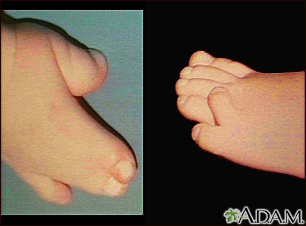Apert syndrome
Acrocephalosyndactyly
Apert syndrome is a genetic disease in which the seams between the skull bones close earlier than normal. This affects the shape of the head and face. Children with Apert syndrome often have deformities of the hands and feet as well.
Images

I Would Like to Learn About:
Causes
Apert syndrome can be passed down through families (inherited) as an autosomal dominant trait. This means that only one parent needs to pass on the altered gene to a child to have the condition.
Most cases may occur without a known family history.
Apert syndrome is caused by one of two changes to the FGFR2 gene. This gene change causes some of the bony sutures of the skull to close too early. This condition is called craniosynostosis.
Symptoms
Symptoms include:
- Early closure of sutures between bones of the skull, noted by ridging along sutures (craniosynostosis)
- Frequent ear infections
- Fusion or severe webbing of the 2nd, 3rd, and 4th fingers, often called "mitten hands"
- Hearing loss
- Large or late-closing soft spot on a baby's skull (fontanelle)
- Possible, slow intellectual development (varies from person to person)
- Prominent or bulging eyes
- Severe under-development of the midface
- Skeletal (limb) abnormalities
- Short height
- Webbing or fusion of the toes
Several other syndromes can lead to a similar appearance of the face and head, but do not include the severe hand and foot features of Apert syndrome. These similar syndromes include:
- Carpenter syndrome (kleeblattschadel, cloverleaf skull deformity)
- Crouzon disease (craniofacial dysostosis)
- Pfeiffer syndrome
- Saethre-Chotzen syndrome
Exams and Tests
Your health care provider will perform a physical exam. Hand, foot, and skull x-rays will be done. Hearing tests should always be performed.
Genetic testing can confirm the diagnosis of Apert syndrome.
Treatment
Treatment consists of surgery to correct abnormal bone growth of the skull, as well as for the fusion of the fingers and toes. Children with this disorder should be examined by a specialized craniofacial surgery team at a children's medical center.
A hearing specialist should be consulted if there are hearing problems.
Support Groups
More information and support for people with Apert syndrome and their families can be found at:
- Children's Craniofacial Association: ccakids.org
When to Contact a Medical Professional
Contact your provider if you have a family history of Apert syndrome or you notice your baby's skull is not developing normally.
Prevention
Genetic counseling may be helpful if you have a family history of this disorder and are planning to become pregnant. Your provider can test your baby for this disease during pregnancy.
References
Goldstein JA, Davit AJ, Losee JE. Pediatric plastic surgery. In: Zitelli BJ, McIntire SC, Nowalk AJ, Garrison J, eds. Zitelli and Davis' Atlas of Pediatric Physical Diagnosis. 8th ed. Philadelphia, PA: Elsevier; 2023:chap 23.
Kinsman SL, Johnston MV. Congenital anomalies of the central nervous system. In: Kliegman RM, St. Geme JW, Blum NJ, Shah SS, Tasker RC, Wilson KM, eds. Nelson Textbook of Pediatrics. 21st ed. Philadelphia, PA: Elsevier; 2020:chap 609.
Mauck BM. Congenital anomalies of the hand. In: Azar FM, Beaty JH, eds. Campbell's Operative Orthopaedics. 14th ed. Philadelphia, PA: Elsevier; 2021:chap 80.
National Center for Advancing Translational Sciences. Genetic and Rare Diseases Information Center website. Apert syndrome. rarediseases.info.nih.gov/diseases/5833/apert-syndrome. Updated February 2023. Accessed October 17, 2023.
BACK TO TOPReview Date: 9/18/2023
Reviewed By: Anna C. Edens Hurst, MD, MS, Associate Professor in Medical Genetics, The University of Alabama at Birmingham, Birmingham, AL. Review provided by VeriMed Healthcare Network. Also reviewed by David C. Dugdale, MD, Medical Director, Brenda Conaway, Editorial Director, and the A.D.A.M. Editorial team.

Health Content Provider
06/01/2025
|
A.D.A.M., Inc. is accredited by URAC, for Health Content Provider (www.urac.org). URAC's accreditation program is an independent audit to verify that A.D.A.M. follows rigorous standards of quality and accountability. A.D.A.M. is among the first to achieve this important distinction for online health information and services. Learn more about A.D.A.M.'s editorial policy, editorial process and privacy policy. A.D.A.M. is also a founding member of Hi-Ethics. This site complied with the HONcode standard for trustworthy health information from 1995 to 2022, after which HON (Health On the Net, a not-for-profit organization that promoted transparent and reliable health information online) was discontinued. |
The information provided herein should not be used during any medical emergency or for the diagnosis or treatment of any medical condition. A licensed medical professional should be consulted for diagnosis and treatment of any and all medical conditions. Links to other sites are provided for information only -- they do not constitute endorsements of those other sites. © 1997- 2025 A.D.A.M., a business unit of Ebix, Inc. Any duplication or distribution of the information contained herein is strictly prohibited.
